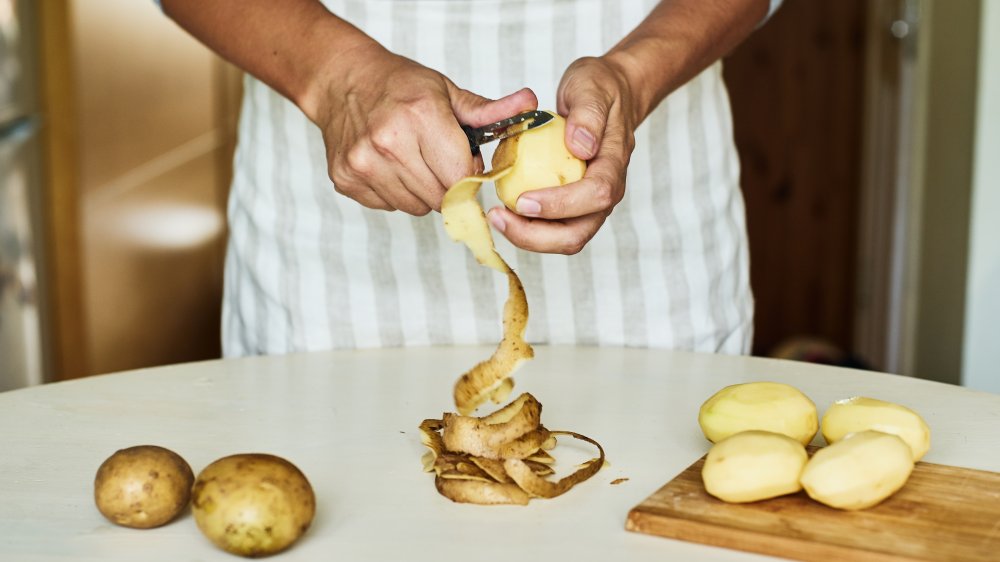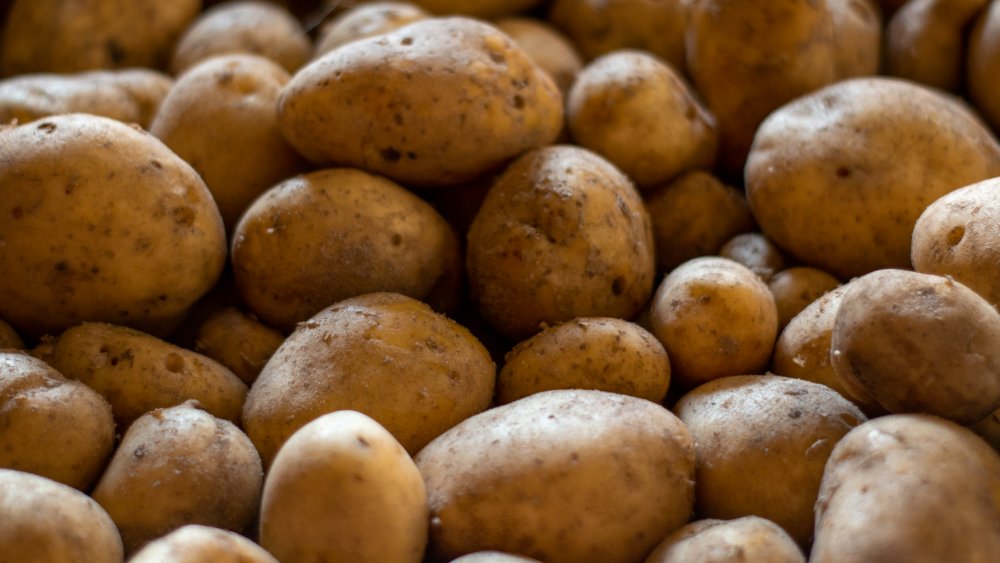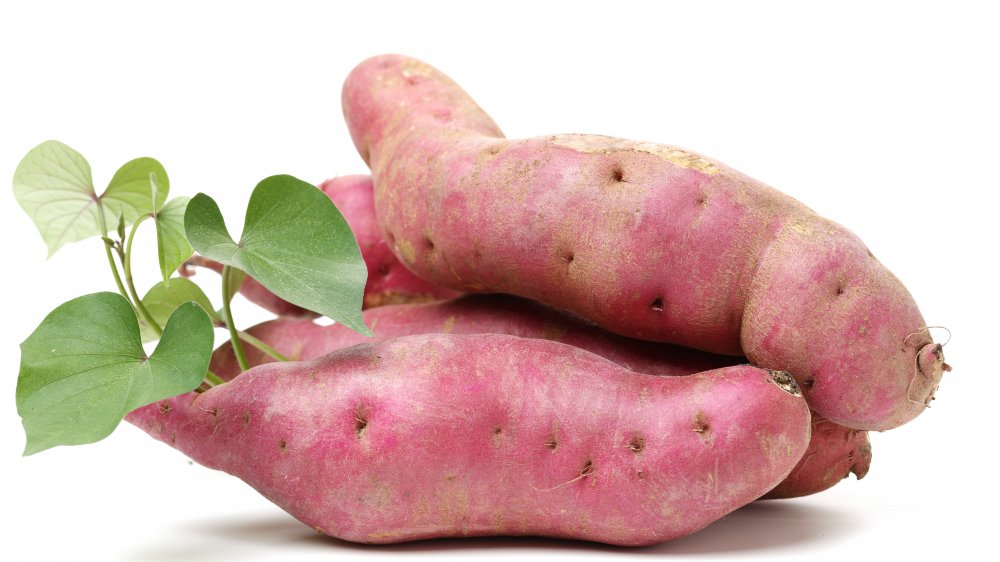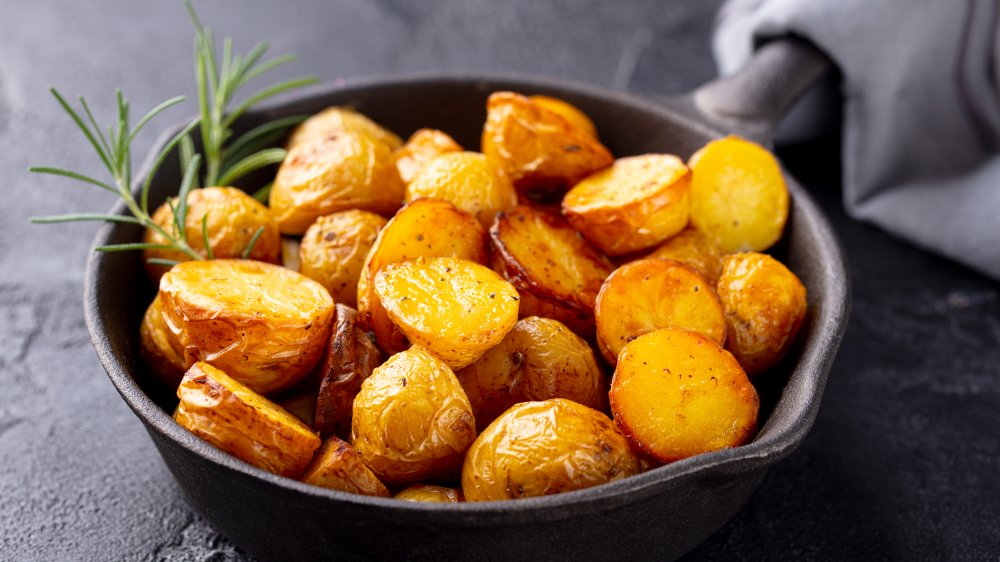You've Been Eating Potatoes Wrong This Whole Time
What's the best way to eat a potato? Considering the average American consumes over 124 pounds of potatoes each year (via Idaho Potato Museum), it shouldn't surprise anyone to hear there are countless ways to enjoy potatoes. Baking, mashing, frying, and everything in between, we love this starchy tuber and it loves us back. According to Potato Goodness, potatoes are high in vitamins C and B6 and contain more potassium than a banana. They also contain complex carbohydrates that provide energy for your muscles and fuel for your brain. Who doesn't need more of that?
But the real secret to eating potatoes starts way before you chow down – with the prep work. We're not here to add things to your to-do list. Rather, there's one step you can remove from your potato prep routine altogether: peeling them. That's right! No more precious minutes wasted shaving the skin from your spuds, desperately trying to avoid nicking your knuckles with the vegetable peeler. Keep those potato skins intact, and not only will you save yourself time, but you'll boost the nutrition content of your meal in the process.
Leaving the skin on your potatoes boosts the nutritional content
Potato skin is notably high in fiber (via SF Gate), which is effective in maintaining a healthy weight. One whole baked potato will also provide a significant amount of your daily iron intake (57 percent for men and 25 percent for women) and the majority (88 percent) of that iron content is found in the skin. Iron regulates the growth of cells that fight pathogens, which is important for a healthy immune system.
Potato skin also contains immunity-boosting vitamin C, potassium for healthy muscles, and phytochemicals which potentially protect the body from heart disease and cancer. Potatoes and their skin are fat-free and contain small amounts of high-quality plant protein, making them an all-around great choice for your diet, according to Healthline. Just be sure to keep your fried potato indulgences like chips and french fries to a minimum, and stick to healthier preparations like baking and boiling.
Sweet potato skin is good for you too
What about the potato's copper-colored cohort, the sweet potato? They're not technically related, although they're both called potatoes. White potatoes are nightshades and sweet potatoes are part of the same family as the morning glory (via Precision Nutrition). But sweet potato skins are just as edible as other potato skins and come with a few added benefits, too.
In addition to 13 percent of your daily fiber and seven percent of your recommended daily energy-boosting complex carbs in a 100-gram serving (via Livestrong), the National Institutes of Health says a baked sweet potato with its skin can provide 156 percent of your daily recommended intake of vitamin A. Vitamin A plays an important role in immune function, vision, reproduction, and cellular communication. The flesh of a sweet potato is also rich in beta-carotene, which is a powerful antioxidant that can help protect cells from free radicals (via SF Gate). Both tasty and nutritious, sweet potatoes and their skins can be a win-win for your health.
Just make sure to clean your potatoes well before enjoying them
This is all great news, and we're more than happy to ditch the laborious task of peeling anyway, but a bonus of saving your potato skins is that they can taste amazingly good! A baked potato's skin that's been salted and crisped to perfection is a revelation. Leaving the thin, wispy skins on mashed Yukon Golds adds a rustic, delicious touch of charm and can cure all your comfort food cravings. And don't forget skin-on sweet potato nachos topped with ground turkey and fresh veggies. So what if the skin can be odd-looking and sometimes covered in dirt? Okay, no one wants to eat funny-looking, dirty potatoes.
Grit, growths, and — even worse — toxins, have no place in these culinary delights. Step one to a clean spud is to wash and scrub your potato well under cold, running water, using a brush or kitchen towel to remove dirt. Simply Recipes says if your potato has small, nubby sprouts, to remove those with a knife. If a white potato's skin or the flesh itself has a green tint, cut that part away to avoid ingesting anything toxic. Cooking Light explains the green tint signals a build-up of a toxin called solanine, which can cause headaches, nausea, and fatigue if consumed. Once your potatoes are clean and trimmed of any sprouts or green-colored spots, you're ready to cook the spuds of your dreams, skins and all!



